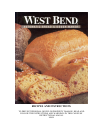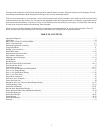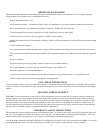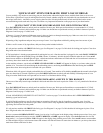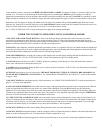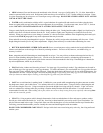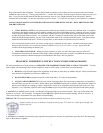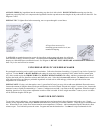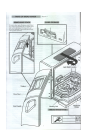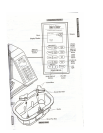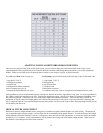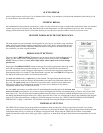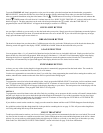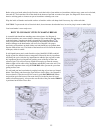6
• MILK enhances flavor and increases the nutritional value of bread. Any type of milk (whole, 2%, 1%, skim, buttermilk or
canned evaporated milk) can be used. Refrigerated milk must always be warmed to 75-85° F before adding to bread pan. Warm
in a glass measuring cup in microwave or in a small pan on top of the range. DO NOT HEAT MILK ABOVE 110° F AS THIS
COULD AFFECT THE YEAST.
• WATER used in combination with dry milk is a good substitute for regular milk and must be used when using the timer
feature as regular milk can spoil when left at room temperature for several hours. Use lukewarm water, about 75-85° F, for best
results. DO NOT USE WATER ABOVE 110° F AS THIS COULD AFFECT THE YEAST.
Using too much liquid can cause the bread to collapse during the bake cycle. During humid weather, slightly less liquid may be
needed, as the flour will absorb moisture from the air. In dry weather, slightly more liquid may be needed as flour can lose
moisture. When you experience a severe change in weather, it is best to check the condition of the dough during the knead cycle
as noted in the FLOUR paragraph for any minor adjustment that may be needed.
Water and milk are mostly interchangeable in recipes. Eliminate dry milk in recipes when substituting milk for water. Check
dough during the knead cycle for any minor adjustments. Slightly more milk may be needed when substituting for water.
• BUTTER, MARGARINE, OTHER FATS and OILS serve several purposes as they tenderize the bread, add flavor and
richness and contribute to the storage life of bread by retaining moisture. An excess of fat, however, can inhibit rising, so
accuracy is critical.
Butter, margarine and solid shortening are interchangeable in recipes. You may wish to cut butter and margarine into four (4)
pieces for faster blending during the knead cycle. Low-fat or fat-free bread can be made by substituting equal amounts of
unsweetened applesauce or plain nonfat yogurt for the amount of fat recommended in the recipe. Watch dough as it kneads for
any minor adjustments, which may be necessary.
• EGGS add color, richness and leavening to bread. Use large eggs. No premixing is needed. Egg substitutes can be used in
place of fresh eggs. One egg equals ¼ cup of egg substitute. To reduce cholesterol, you can substitute two (2) egg whites for each
large egg in the recipes without affecting the end result. Watch the dough during the knead cycle for any needed adjustments. See
“Special Notes on Flour” section on pages 3 and 4 for adjusting dough. A special tip when using eggs is to run them under warm
water for about one minute before cracking, as this helps the egg slide out of the shell better.
• SALT has several functions in making bread. It inhibits the yeast growth while strengthening the gluten structure to make
the dough more elastic, plus it adds flavor. Use ordinary table salt in your bread maker. Using too little or eliminating the salt
will cause the dough to over-rise. Using too much can prevent the dough from rising as high as it should. “Light” salt can be
used as a substitute for ordinary table salt, providing it contains both potassium chloride and sodium. Use same amount as
recommended for table salt. When adding salt to pan, add to one corner to keep it away from yeast, especially when using timer
as the salt can retard its growth.
• YEAST is a living organism, which, through fermentation, feeds on carbohydrates in flour and sugar to produce carbon
dioxide gas, which makes the bread rise. Active dry, fast rising or bread machine yeast can be used in your bread maker. Use
only the amount stated in the recipe. Using a little more can cause the dough to over-rise and bake into the top of bread maker.
Fast rising yeast and bread machine yeast are virtually the same and interchangeable with one another.
DO NOT USE COMPRESSED CAKE YEAST. Recipes in this book were tested using only active dry, fast rising and bread
machine yeast.



